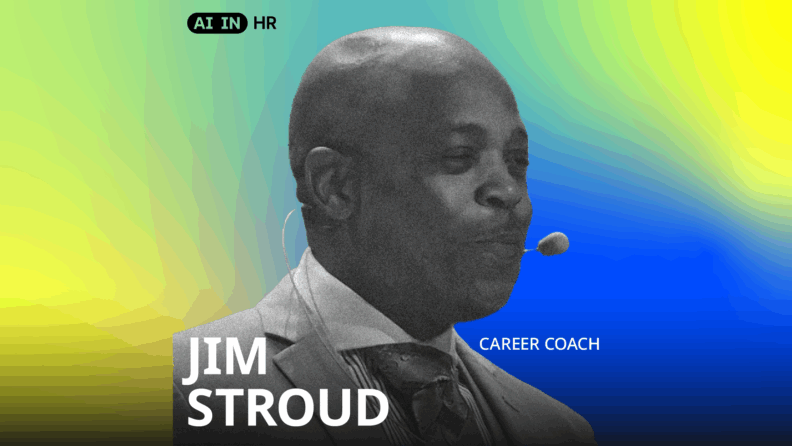Today, as the host of The Jim Stroud Podcast, creator of The Recruiting Life newsletter, and author of five HR books, he explores how technology—especially AI—is reshaping the talent landscape.
We spoke with Jim to understand how AI is changing the sourcing game. He shared the risks, as well as how to mitigate them.
Jim Stroud’s HR Journey Across Microsoft, Google, Siemens, and More
I like to say my career has been equal parts curiosity and persistence. Over the past decade, I’ve worn a lot of hats—sourcing strategist, public speaker, consultant, content creator, and more—but the common thread has always been helping people and companies connect in smarter, more meaningful ways.
I’ve had the privilege of working with organizations like Microsoft, Google, and Siemens, as well as scrappy startups trying to punch above their weight. At Randstad Sourceright, I served as Global Head of Sourcing and Recruiting Strategy, supporting clients around the world as they navigated some of the toughest challenges in hiring. My last full-time role was serving as Editor for SourceCon, the premier conference for all things sourcing. There, I secured speakers from across the globe, managed an online community of passionate practitioners, and promoted the event with every type of content you can imagine.
These days, my work takes several forms. I publish The Recruiting Life newsletter and host The Jim Stroud Podcast — both centered on what’s happening now and next in the world of work. I also ghostwrite for HR tech companies and advise executives on their job-search strategies. I stay busy.
Along the way, I’ve built and sold digital properties, authored five HR books, and spoken on stages across Europe, Asia, and the U.S. But titles and platforms aside, my leadership journey has really been about learning how to build trust, spark ideas, and lead conversations in our industry.
And when I’m not doing that? You’ll usually find me with my family, watching Marvel movies — or trying to convince myself that chocolate-chip cookies count as a form of therapy.
While AI Is Changing Leadership, Timeless Principles Stay the Same
If there’s one thing my career has taught me, it’s that the tools may change, but the foundation of leadership stays the same.
The tools may change, but the foundation of leadership stays the same.
I like to think of it like building a house. You can swap out the hammer for a nail gun, but you still have to pour the concrete, put up the frame, and make sure the foundation holds.
Back in the 1990s, long before AI came along, eGrabber first hit the market. And a lot of sourcers thought their jobs were finished.
The fear was, "Who needs a sourcer if software can find candidates faster and cheaper?" But the tool could only do so much. It couldn’t gauge interest, build relationships, or sell an opportunity in a way that made someone lean in.
And as a result, the sourcers who adapted—who understood the limits of the tool and filled in the gaps—became even more valuable.
I see the same pattern now with AI. These tools can do a lot, and sure, people feel threatened — but history repeats itself. The people who learn, listen, and adapt will always find a way to thrive.
Why Upskilling Beats Downsizing as the Smartest Ai-Era Leadership Strategy
If you’re a leader, your best move in the AI-era isn’t cutting headcount — it’s developing your people. And helping them to leverage AI more effectively.
Upskill them. Train them. Invest in them. When you do that, three things happen:
- Your employees become more valuable.
- You make your company more attractive to future talent.
- You ensure higher-quality work because people give their best when the company invests back into them.
And don’t keep it quiet. Talk openly about the fact that you’re upskilling your people. Share it on your career page, on social media, and in your recruiting outreach. Candidates notice.
This ensures the highest quality of work from your employees. Why? Simply put, who wants to give their best to a company that’s already hinting that they’ll be replaced by AI?
Why AI Literacy Is Now the Top Skill Companies Should Assess
If I were hiring today, AI literacy would be one of the first things I’d quiz a candidate on.
If I were hiring today, AI literacy would be one of the first things I’d quiz a candidate on.
Why? Because the future of work isn’t massive conglomerates run by thousands of people anymore — it’s big companies run by small, lean teams powered by AI.
Cursor hit $200 million with just thirty employees. MidJourney matched it with forty. A Swedish startup called Lovable hit a $1.8 billion valuation with a team you could squeeze into a small bus.
These aren’t anomalies; they’re the blueprint.
So yes, I’d want to know how AI-ready someone is. Am I looking for experts? No. I’d be looking for people who know enough to be dangerous and have a passion to learn more. As such, I’d ask very specific things, like:
- Show me how you manage your life with AI.
- Tell me about a time when you used a multi-step prompt to solve a problem or learn something.
- If I give you a new problem, walk me through how you’d use AI to approach it.
- Show me where you’ve shared your AI work on social media.
- Tell me about a time AI didn’t work for you — what did you do next?
- And finally, how many LLMs do you use daily, and for what?
Because in today’s world, it’s not just whether you use AI — it’s how well you use it.
How AI Workflows Can Increase Efficiency Without Causing Burnout
AI has absolutely changed the way I lead. And the biggest way it has done that is by making me more efficient and allowing me to take on more without burning out. It can do this for anyone.
Earlier this year, I joined a virtual session hosted by LexDuo — a company that teaches recruiters how to use AI and even build their own tools. It was a game-changer. Seeing how no-code platforms can power everything from simple job boards and application forms to a lightweight ATS, CRM, interview scheduler, and recruiter dashboard blew my mind. No-code really means no code. It’s a way to build systems through ideas, not techie computer code — where someone with zero tech background can create fully functional recruiting tools that work right out of the gate. Wild stuff.
But you need to have the right systems built around it. Because that extra time is a gift, but it also comes with a warning label. The danger is thinking, “I can do more with less,” and then giving in to the temptation of simply… doing more. Before long, you lose all the time you thought you had saved.
The added efficiency from AI comes with a warning label. The danger is thinking, “I can do more with less,” and then giving in to the temptation of simply… doing more. Before long, you lose all the time you thought you had saved.
As an example, I built a system that lets me research prospects, identify marketing gaps, and automatically generate outreach emails. That process helps me secure a steady stream of clients every month. If I wanted to, I could easily triple my client list using the same system. But here’s the thing — scaling like that would lead straight to burnout.
I’ve learned not to let efficiency become a trap. Sure, I could keep taking on more, chase every project, and make an obscene amount of money. Instead, I’ve chosen balance. I only take on a set number of clients at a time. That sometimes means a waiting list, but it also means I can deliver my best work without burning out.
Every LLM Has Its Place: Building a Flexible AI Tool Stack
As far as my tech stack, ChatGPT’s my daily driver — the Swiss Army knife of AI. I use it for everything: brainstorming, editing, solving tech hiccups, you name it.
But no single AI tool does everything well. That’s why I use multiple LLMs — I’ve found some perform better with certain tasks than others.
- I use Perplexity for deep research.
- Claude is my go-to editor. It’s got that clean, thoughtful rhythm that makes writing feel smarter.
- NotebookLM — that one’s the quiet genius. It reads long docs like it’s flipping through a novel — sharp, calm, always on point.
- Grok’s the wild card — part trend tracker, part stand-up comic. The other day it dropped, “What do you call a fake noodle at a job interview? An impasta.” Hah! That still cracks me up.
- I’m a little obsessed with MidJourney. The creative imagery I can make with it, and now even video, has really leveled up my game. Strong imagery draws people in, earns attention, and makes them more likely to value the words that follow. MidJourney has given me that edge, making my work stand out before the first sentence is even read.
- I’ve also been exploring tools like DeepSeek and Z.ai from China and comparing them to other models. I've found that, while ChatGPT gives me balanced, user-friendly answers with clear options and follow-ups. DeepSeek tends to respond more technically. And Z.ai produces clear, detailed answers — and sometimes even links to visual examples. I haven’t done a deep dive on either yet, but if I do, I’d probably steer clear of geopolitical or cultural prompts since China heavily censors politically sensitive topics — think #TiananmenSquare.
The truth is, my stack changes constantly. I’m always open to trying out something new if it helps me work smarter — or if something works better than the tools I'm already using.
That mindset—treating AI not as one magic solution, but as a toolbox—has probably been my biggest advantage as a leader.
AI Bias in Recruiting: Why Human Oversight Is Essential
AI doesn’t always live up to the hype, though. It makes mistakes—hallucinations mostly—and sometimes you spend more time double-checking the work than you’d like. That can cost you big time on the back end.
AI doesn’t always live up to the hype. It makes mistakes—hallucinations mostly—and sometimes you spend more time double-checking the work than you’d like. That can cost you big time on the back end.
And it’s not just personal experience:
- Amazon had to scrap a recruiting AI that downgraded women’s resumes for technical roles.
- iTutor Group’s HR system rejected women over 55 and men over 60, regardless of qualifications.
- Lawyers using ChatGPT cited fake legal cases in court, leading to public embarrassment.
- Studies show resume filters still lean toward “white-sounding” names over equally qualified Black candidates.
Then there’s the MIT research: 95% of generative AI pilots at companies are failing. Fortune magazine reported that only about 5% actually deliver measurable revenue impact, while the rest stall out.
All of this tells me that this genie-in-a-bottle thinking is dangerous.
So, are AI tools worth it? On the whole, yes — but only with the right oversight. You need humans in the loop to check accuracy and apply judgment.
Here's a simple recruiting workflow where humans and machines can work together to avoid these issues.
Automated: AI scans job boards, internal databases, and LinkedIn to identify potential candidates based on keywords and experience. It then ranks those profiles by match score.
Human-in-the-loop: The recruiter reviews the AI-ranked candidates and applies judgment on things like cultural-fit indicators, non-obvious potential career changers, unique backgrounds, and diversity considerations. Humans need to check on that ranking algorithm on a regular basis to make sure outliers get fair consideration. A third party may be best for this, because too often, out of habit, recruiters blindly trust the machines and abandon their own judgment.
Tools are powerful, but without people who know what “right” looks like, they can do more harm than good.
Tools are powerful, but without people who know what “right” looks like, they can do more harm than good.
Why Empathy Will Become the Next Leadership KPI in an Ai-First World
At the end of the day, great leadership isn’t just about keeping up with technology — it’s about keeping people at the center. And that’s exactly why I think empathy will become a KPI.
By 2030, leaders won’t just be measured on revenue or growth — they’ll be measured on empathy. And with AI, they’ll actually have the tools to do it — through employee feedback loops, sentiment analysis, and even biometric data.
By 2030, leaders won’t just be measured on revenue or growth—they’ll be measured on empathy.
Why? Because mental health and inclusion aren’t side conversations anymore; they’re front and center. If a leader can’t foster psychological safety, they’ll be obsolete.
Charisma will become the knockout quality in CEO interviews. Being able to connect, inspire, and come across as genuinely human won’t be optional; it’ll be expected.
Leaders like Steve Jobs, Jeff Bezos, and Elon Musk are legendary today because they had that mix of foresight, strategy, and charisma that inspired employees to give their all while creating cult-like followings among customers. That’s exactly the kind of leadership that will command billion-dollar compensation packages in the future.
Need expert help selecting the right Other Software?
If you’re struggling to choose the right software, let us help you. Just share your needs in the form below and you’ll get free access to our dedicated software advisors who match and connect you with the best vendors for your needs.
Follow Along
You can follow Jim’s work on LinkedIn and X as he continues to explore and explain how AI is transforming the world of work. And check out his website and ongoing projects: The Jim Stroud Podcast and The Recruiting Life newsletter.
More expert conversations to come here soon on People Managing People!




